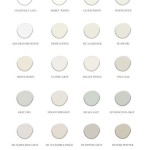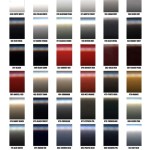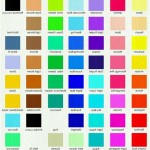What Does A Ford Paint Code Look Like On Cars?
Identifying the correct paint code for a Ford vehicle is essential for ensuring accurate color matching during repairs or touch-ups. The paint code, a combination of letters and numbers, precisely defines the specific shade and formulation used on the vehicle at the time of manufacture. Locating and understanding this code is the first step towards achieving a seamless and professional-looking paint job.
Ford paint codes typically consist of two characters, although some older models or specific paint types may utilize codes with up to six characters. These characters can be a combination of letters and numbers, strategically arranged to represent the color's unique properties. This code is crucial for automotive paint suppliers and body shops, allowing them to mix the exact color required for a perfect match.
The information contained within a Ford paint code goes beyond simply identifying the color name. It encompasses the specific pigments, quantities, and mixing ratios needed to replicate the original factory finish. This level of detail is particularly important for metallic, pearlescent, and tri-coat paints, which are known for their complex formulations and require precise application to achieve the desired effect.
The process of accurately identifying and interpreting the Ford paint code is paramount for anyone involved in automotive refinishing. Submitting an incorrect paint code to a supplier can result in a mismatched color, leading to a visually unappealing and potentially costly mistake. Therefore, understanding where to find the paint code and how to decipher it is a valuable skill for car owners, body shop technicians, and automotive enthusiasts alike.
Locating the Ford Paint Code
Finding the paint code on a Ford vehicle typically involves searching for a sticker or label, often referred to as the Vehicle Identification Number (VIN) sticker or door jamb sticker. This sticker contains a variety of information about the vehicle, including the VIN, manufacturing date, tire pressure specifications, and, most importantly, the paint code.
The most common location for this sticker is on the driver's side door jamb. This is the area where the door meets the frame of the car when it's closed. Open the driver's side door and carefully examine the door frame for a white or silver sticker. The sticker is usually placed either on the door pillar or on the edge of the door itself.
If the door jamb sticker is missing or damaged, alternative locations to check include the engine compartment, specifically the firewall or the radiator support. These areas often have a similar sticker containing vehicle information. Another place to explore is the glove compartment. In some Ford models, the paint code may be listed on a sticker inside the glove compartment door.
Once the sticker is located, the next step is to identify the paint code within the other information present. The paint code is usually labeled with terms like "EXT PNT," "PAINT," "EXTERIOR PAINT," or simply "COLOR." The code itself will be a two-character alphanumeric sequence, such as "YN," "UX," or "PQ." It's crucial to differentiate the paint code from other codes or numbers on the sticker, such as the trim code or the vehicle identification number.
In some instances, the paint code might be accompanied by a longer, more descriptive name of the color. However, relying solely on the color name can be unreliable, as the same color name may have been used for different paint formulations over the years. Always use the alphanumeric paint code to ensure the correct color match.
If the sticker is unreadable or missing entirely, contacting a Ford dealership with the vehicle's VIN can often provide the correct paint code. Dealership service departments have access to databases that detail the original specifications of each vehicle, including the paint code. It's often required to provide proof of ownership or valid identification during this process for security reasons.
Understanding the Structure of Ford Paint Codes
Ford paint codes, while generally consisting of two characters, can sometimes be more complex, depending on the year and model of the vehicle, as well as the specific paint type used. The two characters typically represent the primary color and any variations or special effects applied to it.
The first character in the paint code usually denotes the primary color family. For example, "Y" might indicate a shade of white, while "U" could represent a blue hue. The second character further refines the color within that family, indicating variations in tone, saturation, or metallic content. The combination of these two characters creates a unique identifier for the specific paint formulation used on the vehicle.
For more complex tri-coat paints or special edition colors, the paint code may be longer, consisting of up to six characters. These longer codes typically include additional alphanumeric characters representing the different layers or components of the paint system. Tri-coat paints, for example, involve a base coat, a mid-coat (often a translucent color or pearlescent effect), and a clear coat. Each of these layers may have its own unique identifier within the longer paint code.
It is important to note that the meaning of specific letters and numbers can vary over time and across different Ford models. There is no universal key that applies to every Ford paint code. The most accurate way to decipher the code is to use it to order paint from a reputable automotive paint supplier or consult with a Ford dealership. These sources have access to the necessary databases and color charts to interpret the code correctly.
When ordering paint based on the code, it is crucial to provide the complete paint code to the supplier. Omitting any characters or misinterpreting the code can result in an incorrect color match. In addition, it is recommended to order a small quantity of paint initially and perform a test spray on an inconspicuous area of the vehicle to verify the color match before applying it to a larger area.
The paint code may also be referred to as the "color code." This term is synonymous and refers to the same alphanumeric identifier used to specify the paint color. Regardless of the terminology used, the key is to accurately locate and record the code from the vehicle and provide it to the paint supplier for accurate color matching.
Matching Paint and Potential Challenges
While the paint code provides the essential information for matching the original factory finish, several factors can still affect the final result. These factors need to be considered to ensure a seamless and undetectable repair.
One significant challenge is paint fade. Over time, exposure to sunlight, weather, and pollutants can cause the paint on a vehicle to fade or change color. This is particularly noticeable on older vehicles. Even with the correct paint code, the newly applied paint may appear slightly different from the existing paint due to this fading effect.
To mitigate the effects of paint fade, a process called "tinting" may be necessary. Tinting involves adjusting the color of the paint slightly to match the faded color of the vehicle. This requires a skilled paint technician with experience in color matching. The technician will typically compare the newly mixed paint to the existing paint on the vehicle and add small amounts of tinting agents to achieve a closer match.
Another factor to consider is the application technique. The way the paint is applied, including the spray gun settings, the number of coats, and the drying time, can all affect the final color and appearance. It is crucial to use proper painting techniques and equipment to achieve a consistent and professional finish.
Furthermore, the substrate material can also influence the final color. For example, if the repair involves painting over new body panels or filler, the color may appear slightly different compared to painting over the original factory finish. Proper preparation of the substrate, including priming and sanding, is essential to ensure uniform color and adhesion.
Metallic and pearlescent paints are particularly challenging to match due to their complex formulations and the way they reflect light. These paints contain tiny metallic flakes or pearlescent pigments that can settle differently depending on the application technique. Achieving a uniform and consistent distribution of these flakes is crucial for a seamless color match.
Finally, variations in the manufacturing process can also contribute to color differences. Even within the same production run, slight variations in the paint formulation or application process can occur, resulting in subtle differences in the final color. These variations are often imperceptible to the naked eye, but they can become noticeable when comparing newly applied paint to the existing paint on the vehicle.

What Is The Paint Code For My Vehicle

Ford Paint Codes Touch Up Paintscratch Com

How To Find Ford Paint Codes For Precision Matched Touch Up

What Is The Paint Code Of My Vehicle

How To Find A Paint Code On Any Vehicle Fast All Models

3 Ways To Find The Paint Color Code On Ford Vehicles Wikihow

2024 Ford Focus Paint Code Location

Find My Ford Europe Color Code N Drive

Locating Your Vehicle S Paint Code Racingjunk News
Interior Trim Code Guide Seat Doctors
Related Posts








